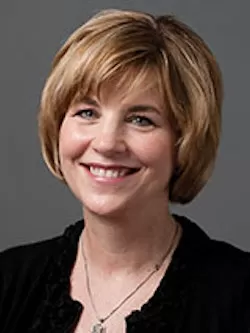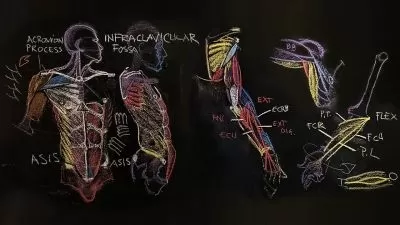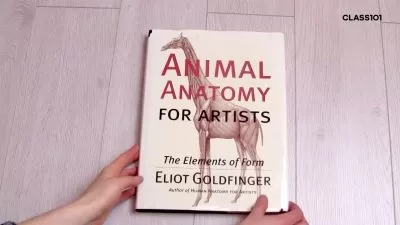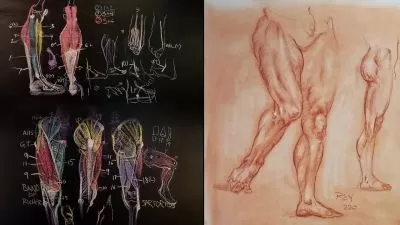How We Move: The Gross Anatomy of Motion
Elizabeth A. Murray
12:35:42
Description
Our bodies are absolutely amazing. Day after day, year after year, our bodies support and move us in incalculable ways. With seemingly little conscious effort on our part, our bodies allow us to walk, run, sit, stand—to move through the world. And yet, our bodies are also prone to devastating injuries, and they are susceptible to the degeneration that can accompany aging and disease. This complex system of bones, muscles, tendons, and other vital parts is deeply fascinating and incredibly varied from person to person. Having a deeper understanding of the structure and abilities of the body can give you insight into an intriguing subject of medical study. It also provides you with a guide for caring for your well-being and for dealing with potential issues of health and mobility.
In How We Move: The Gross Anatomy of Motion, you’ll look inside the human body as never before, discovering your gross anatomy, the parts of the body that can be seen with the unaided eye—your macroscopic body. In this course, you will view graphics, photos, videos, and the digital autopsy table called “Anatomage,” to help your understanding of the topics covered. Professor Elizabeth A. Murray, of Mount St. Joseph University, will take you on a journey through the major regions of the body in all their complex grandeur. It’s safe to say that you’ve never seen anything like it! In 24 fascinating lectures, Dr. Murray shares her passion for the form and function of the human body—a passion that becomes contagious.
A cautionary note: As you may know, medical and anatomical study can be rather graphic in nature. With that in mind, the Anatomage software used in several “Digital Cadaver” lectures employs digital images that are based on real-life cadavers. Viewer discretion is advised for younger viewers and those who may be uncomfortable with these highly realistic anatomical learning tools.
The Vocabulary of Anatomy
As with any field of study, anatomy has its own specific terminology. With a quick overview of the roots of anatomical terminology and some directional terms to get you started, Dr. Murray will take you through many of the bones, muscles, and nerves of the human body, one region at a time. This isn’t about memorization—not only is that not necessary, but, as she explains the logic behind the names, the vocabulary will begin to flow naturally and become easier to understand. For example, consider the extensor digitorum, the muscle that extends the wrist and fingers, or the levator scapulae that elevates the shoulder. As you will see, once you have an understanding of how these words connect with the various parts of the body and how they function, these intimidating terms will feel not only logical, but maybe even familiar.
In addition to the numerous functional names, you’ll learn about some of the more unusual nomenclature and its origins, including:
- Sartorious Muscle. This is one of the muscles you use when you cross your legs to put one leg on top of your opposite knee. The name comes from the Latin for “tailor,” since tailors would sit cross-legged with their fabric in their lap while they worked.
- Snuffbox Muscles. This group of three muscles of the posterior forearm travel to reach the thumb. The surface landmark, known as the anatomical snuffbox, is a triangular region near the thumb where people who used snuff would store their tobacco before snorting it.
- Pudendal Nerve. This major nerve of the pelvic region supplies the sphincter muscles that control urine and feces, as well as the muscles that help maintain sexual health and function. Named in the 17th century, the word comes from the Latin meaning “shameful.”
You Have How Many Bones?
Although you’re aware that you have bones, chances are you don’t know precisely how many you have. No problem. If you needed to know, you could look it up in a variety of resources, right? The fascinating answer is “maybe not.” As you’ll learn, human anatomy has a tremendous amount of variability. In fact, for any given anatomical feature, it’s estimated that only 70% of individuals have the by-the-book pattern or structure. This doesn’t mean 30% of humans are “abnormal”—actually, it means that wide variation in human anatomy is completely normal. Dr. Murray still finds unusual anatomical features when teaching gross anatomy, even after 30 years in the field.
In this course, you will learn about several of the most common anatomical variations, including:
- Palmaris Longus. This muscle of the forearm that helps with wrist flexion is the most variable muscle of the body. Studies conducted on geographically diverse populations reveal a prevalence of anywhere from 36 to 99% variance! If you don’t have it, you can still flex your wrist with no trouble. If you do have it, it could become a “spare” body part in case you should ever need it for surgery.
- Plantaris. This muscle, which weakly flexes the knee and ankle, is present in about 80% of individuals. As with the palmaris longus, you can function just fine without it.
- Pectineus. This muscle is in the groin and it helps flex and adduct the hip joint. In some people, it is supplied by the femoral nerve, in others pectineus is supplied by the obturator nerve, and in some people, it is supplied by both.
What Went Wrong?
The study of anatomy can’t help but inspire a sense of wonder as we consider the human body in all its complexities. But on the flip side, the more we learn about the body, the more we realize how many opportunities there are for injury or disease. In How We Move: The Gross Anatomy of Motion, Dr. Murray puts you in the position of medical sleuth by beginning most of the lectures with a clinical scenario requiring a diagnosis. After learning about the muscles, bones, and nerves of that particular body region, you’ll get the chance to assess some of the problems presented, such as:
- Dowager’s Hump. A 74-year-old woman has developed what’s sometimes called a dowager’s hump in the upper back. Her posture has become stooped in the thoracic region of the spine, causing her to hunch forward. What’s happened over time?
- Spinal Cord Injury. A young man was badly injured in a motor vehicle accident, and his sixth and seventh cervical vertebrae were crushed. His spinal cord was essentially severed at the level of this fracture. Will he be able to breathe on his own or will he require a respirator to breathe for him?
- Broken Hip. A 68-year-old woman stepped out of her car and fell. She felt excruciating pain in her left hip and was unable to get up. She told paramedics that she didn’t think she tripped over anything, the pavement wasn’t wet or slippery, and she wasn’t dizzy or disoriented. What actually caused her fall?
While this course will help you assess patients like these and others, the much more important benefit is what you will learn about yourself. Not only will you develop a deeper understanding of your own body, but you’ll also be better equipped to avoid injury and to take good care of your amazing and marvelous anatomy.
More details
User Reviews
Rating
Elizabeth A. Murray
Instructor's CoursesDr. Elizabeth A. Murray is a forensic anthropologist and also Professor of Biology at Mount St. Joseph University, where she teaches doctoral-level human gross anatomy and undergraduate-level anatomy and physiology, as well as forensic science. She earned her bachelor's degree in biology from Mount St. Joseph University and her master's degree in anthropology and Ph.D. in Interdisciplinary Studies in Human Biology from the University of Cincinnati.
Most of Professor Murray's forensic casework has been in Ohio and Kentucky, where she has participated in hundreds of investigations. She is one of fewer than 100 anthropologists certified as a Diplomate by the American Board of Forensic Anthropology. Professor Murray has been honored with the Sears-Roebuck Foundation Teaching Excellence and Campus Leadership Award, and she twice earned the Clifford Excellence in Teaching Award. She has served as an instructor for numerous organizations, including the U.S. Department of Justice, the Armed Forces Institute of Pathology, and the International Association of Coroners & Medical Examiners. Her television appearances include National Geographic's Buried Secrets, Discovery Health's Skeleton Stories, The New Detectives, and Forensic Files. Her book Death: Corpses, Cadavers, and Other Grave Matters was named one of the top ten summer titles for students by the American Association for the Advancement of Science. Her 2012 book, Forensic Identification: Putting a Name and Face on Death, was selected as one of the outstanding books of 2012 by the prestigious National Science Teacher's Association.

The Great Courses
View courses The Great Courses- language english
- Training sessions 25
- duration 12:35:42
- English subtitles has
- Release Date 2023/08/19









